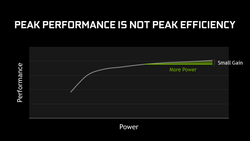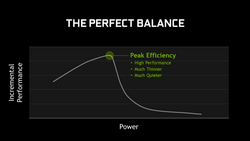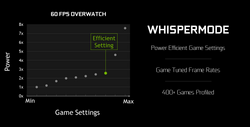Nvidia Max-Q & WhisperMode: Information & Initial Benchmarks
For the original German article, see here.
Graphics cards are not only getting faster with every generation, but they also consume less power and produce less heat thanks to technical optimizations and smaller manufacturing processes. However, the successful implementation of current top models like the Nvidia GeForce GTX 1080 and 1070 is still a challenge for laptop manufacturers. The task of building a gaming laptop that is not only powerful, but at the same time slim, cool, and quiet, is basically like trying to square the circle.
Slim casings in particular require small fans with higher speeds, which are often annoying and still not as successful as larger fans with lower speeds. There is also less space for passive cooling, which can help to reduce frequent and annoying fan pulsating.
So far, gamers have always had to make some compromises: There are very bulky four-kilogram (~8.8 lb) monsters such as the Acer Predator 17 G9-793-70PJ, which do not get overly warm at important sports, have no serious problems with temperature related throttling and create a noise level that is still bearable without headphones. On the other end of the spectrum we have much slimmer and lighter systems with similarly powerful components, but they lack at least some of the mentioned advantages of the large chassis. This is where Nvidia's Max-Q technology comes into play.
Farewell from FPS Race?
The big topic here is to change old priorities, which is certainly not what all gamers want. Max-Q will have a hard time with users looking for the maximum performance, which is certainly the case for many people planning to buy a gaming laptop. Nvidia sacrifices a part of the potential performance to ensure the previously mentioned quiet and cool operation in slim and compact cases. It is therefore not about the maximum performance, but a reasonable performance in consideration of power consumption, emissions, and thermals.
What is Max-Q?
Max-Q graphics cards run at a lower clock compared to their regular counterparts. Standard GPUs, which are limited by the TDP, tend to get inefficient as soon as they exceed a certain point. In short: Once the so called Sweet Spot is exceeded, the consumption increases until it hits the TDP, but without corresponding performance gains. This area under high load is causing the aforementioned temperature and throttling issues, so Nvidia wants to avoid it. Instead, the manufacturer wants to create a balance between performance and power efficiency.
Among others, the Sweet Spot depends on the quality of each individual chip. So far Nvidia has not confirmed that Max-Q cards will get selected chips, but it can be assumed so due to the higher price of the Max-Q versions.
Statement Nvidia, 28.6.2017: "We are not binning. Pricing will depend on the OEM and the design. A laptop is an integrated system and pricing depends on a wide variety of factors. Max-Q is a new approach to building the best slim, light and powerful laptops, and has required extended work from NVIDIA and the OEMs in R&D."
Laptops with Max-Q labels have to meet some requirements from Nvidia. These include the PCB and the voltage transformers, but mainly the targeted system noise of up to 40 dB(A). It seems that Nvidia has implemented an acoustic controller into the drivers, which controls the power consumption accordingly. Laptop manufacturers can reduce the GPU TDP of Max-Q GPUs significantly without affecting the performance too much; there were talks about ten percent at Computex 2017.
Manufactures can also offer tools to remove the Max-Q limitations, to increase the performance in very demanding games, for example. However, it seems that Max-Q always has to be the default setting or activated out of the box.
Statement Nvidia, 28.6.2017: "It cannot be disabled. NVIDIA is not limiting overclocking, and some Max-Q laptops feature a high performance mode, which allows users to optionally trade off acoustics for higher performance."
The optional WhisperMode
The WhisperMode, which is independent of the hardware, takes a different approach. It can be activated via GeForce Experience in addition to Max-Q or as a standalone feature. WhisperMode is supposed to be available for all Pascal graphics cards and currently works with more than 400 gaming profiles created by Nvidia. The feature automatically chooses graphics presets optimized for the GPU, and limit the frame rate to 40 (e.g. “The Witcher 3”) or 60 frames per second (“Overwatch”), respectively. Users can always change Nvidia's presets manually.
Nvidia acknowledges that different genres or titles have different requirements in terms of FPS for an enjoyable gaming experience. The manufacturer wants to use this technology to improve the efficiency even further and reduce the system noise considerably. We think this feature makes the most sense if the laptop is equipped with a G-Sync display.
Update: Benchmark Comparison GTX 1060 Max-Q
We have first data for a benchmark comparison available from our review of the HP Omen 15-ce002ng with Nvidia GeForce GTX 1060 Max-Q. We compared it in three notebooks with standard GTX 1060 (laptop): The EVGA SC15 has a particularly high 3DMark 11 graphics score, while the Asus Strix GL502VM-DS74 represents the average and the Razer Blade (2017) trails the pack with 10% lower performance than the EVGA.
Our HP Omen cannot even keep up with the relatively slow Razer Blade and is 4% and 5% slower in 3DMark 11 (GPU) and the Fire Strike test of the newer 3DMark (2013), respectively. It even performs 14 and 10%, respectively, worse than the especially fast EVGA. We used the Schenker XMG P507 (GTX 1060) for comparison of the Time Spy and Ice Storm (3DMark), Luxmark, and Cinebench Open GL benchmarks, since we do not have results from the devices mentioned above.
It is suspicious that the HP Omen with Max-Q performs better than the Schenker P507 in the (less and less important) Ice Storm benchmark. In all other benchmarks that we have run, the Omen comes out last. We cannot explain this anomaly. From the overview below, you might get the impression that the Max Q GPU's performance loss in comparison to standard 1060 graphics cards is higher under high graphics load than under moderate load (Cinebench for example).
| 3DMark 11 - 1280x720 Performance GPU | |
| NVIDIA GeForce GTX 1060 Mobile | |
| NVIDIA GeForce GTX 1060 Mobile | |
| NVIDIA GeForce GTX 1060 Mobile | |
| NVIDIA GeForce GTX 1060 Max-Q | |
| 3DMark - 1920x1080 Fire Strike Graphics | |
| NVIDIA GeForce GTX 1060 Mobile | |
| NVIDIA GeForce GTX 1060 Mobile | |
| NVIDIA GeForce GTX 1060 Mobile | |
| NVIDIA GeForce GTX 1060 Max-Q | |
| ComputeMark v2.1 - 1024x600 Normal, Score | |
| NVIDIA GeForce GTX 1060 Mobile | |
| NVIDIA GeForce GTX 1060 Mobile | |
| NVIDIA GeForce GTX 1060 Max-Q | |
| 3DMark | |
| 2560x1440 Time Spy Graphics | |
| NVIDIA GeForce GTX 1060 Mobile | |
| NVIDIA GeForce GTX 1060 Max-Q | |
| 1280x720 Ice Storm Standard Graphics | |
| NVIDIA GeForce GTX 1060 Max-Q | |
| NVIDIA GeForce GTX 1060 Mobile | |
| LuxMark v2.0 64Bit | |
| Room GPUs-only | |
| NVIDIA GeForce GTX 1060 Mobile | |
| NVIDIA GeForce GTX 1060 Max-Q | |
| Sala GPUs-only | |
| NVIDIA GeForce GTX 1060 Mobile | |
| NVIDIA GeForce GTX 1060 Max-Q | |
| Cinebench R15 - OpenGL 64Bit | |
| NVIDIA GeForce GTX 1060 Mobile | |
| NVIDIA GeForce GTX 1060 Max-Q | |
Update: Gaming Benchmarks GeForce GTX 1060 Max-Q
In the gaming comparison, the GTX 1060 Max-Q in the Omen 15 also almost always trails the pack. It only got 2nd of three in the terribly PC ported “Batman Arkham Knight” (High Preset) and the “Witcher 3” (High). In the listed titles, the Max-Q variant performs worse than the fastest GTX 1060 by 8% to quite high 24 % in the very demanding “Rise of the Tomb Raider”.
In the Omen 15's defense, we want to point out that none of the games listed below that could be smoothly played with a standard GTX 1060 became unplayable in maximum 1080p setting. However, the FPS reserves, which might be important for features such as V-Sync, got smaller. Those who want to enjoy games such as “Tomb Raider” and “The Witcher 3” in Full HD and maximum finery will appreciate every additional FPS. The GTX 1060 is not suitable for gaming in 4K resolution anyway, but 10% higher performance can make the difference here: sink or swim?
| Rise of the Tomb Raider | |
| 1920x1080 Very High Preset AA:FX AF:16x | |
| NVIDIA GeForce GTX 1060 Mobile | |
| NVIDIA GeForce GTX 1060 Mobile | |
| NVIDIA GeForce GTX 1060 Mobile | |
| NVIDIA GeForce GTX 1060 Max-Q | |
| 1920x1080 High Preset AA:FX AF:4x | |
| NVIDIA GeForce GTX 1060 Mobile | |
| NVIDIA GeForce GTX 1060 Max-Q | |
| Prey - 1920x1080 Very High Preset AA:2TX SM AF:16x | |
| NVIDIA GeForce GTX 1060 Mobile | |
| NVIDIA GeForce GTX 1060 Max-Q | |
| For Honor - 1920x1080 Extreme Preset AA:T AF:16x | |
| NVIDIA GeForce GTX 1060 Mobile | |
| NVIDIA GeForce GTX 1060 Max-Q | |
| Deus Ex Mankind Divided | |
| 1920x1080 Ultra Preset AA:2xMS AF:8x | |
| NVIDIA GeForce GTX 1060 Mobile | |
| NVIDIA GeForce GTX 1060 Max-Q | |
| 1920x1080 High Preset AF:4x | |
| NVIDIA GeForce GTX 1060 Mobile | |
| NVIDIA GeForce GTX 1060 Max-Q | |
| Doom - 1920x1080 Ultra Preset AA:SM | |
| NVIDIA GeForce GTX 1060 Mobile | |
| NVIDIA GeForce GTX 1060 Mobile | |
| NVIDIA GeForce GTX 1060 Max-Q | |
| Batman: Arkham Knight | |
| 1920x1080 High / On AA:SM AF:16x | |
| NVIDIA GeForce GTX 1060 Mobile | |
| NVIDIA GeForce GTX 1060 Max-Q | |
| NVIDIA GeForce GTX 1060 Mobile | |
| 1920x1080 High / On (Interactive Smoke & Paper Debris Off) AA:SM AF:8x | |
| NVIDIA GeForce GTX 1060 Mobile | |
| NVIDIA GeForce GTX 1060 Max-Q | |
| The Witcher 3 | |
| 1920x1080 Ultra Graphics & Postprocessing (HBAO+) | |
| NVIDIA GeForce GTX 1060 Mobile | |
| NVIDIA GeForce GTX 1060 Mobile | |
| NVIDIA GeForce GTX 1060 Max-Q | |
| 1920x1080 High Graphics & Postprocessing (Nvidia HairWorks Off) | |
| NVIDIA GeForce GTX 1060 Mobile | |
| NVIDIA GeForce GTX 1060 Mobile | |
| NVIDIA GeForce GTX 1060 Max-Q | |
Benchmark Comparison GTX 1070 Max-Q
In the meanwhile, we had the chance to benchmark the MSI GS63VR 7RG with Nvidia GeForce GTX 1070 Max-Q. Unfortunately, we did not have a test model with the GTX 1070 Max-Q in time for this article, so we have to rely on unofficial scores from two manufacturers that do not want to be mentioned. We do no have pure GPU scores either, so we have to use 3DMark11 overall scores instead. We took two laptops with the standard version of the GTX 1070 and the i7-7700HQ from our database to evaluate the results. One of the laptops is at the top, and one at the bottom of the small performance range.
The performance loss by Max-Q is not that big since the regular GTX 1070 GPUs are only 7 to 12% faster. Contrary to initial expectations, the Max-Q-1070 in the MSI GS63VR performs significantly worse than its conventional counterparts in the Asus and Acer. It is 16% and 8% slower than the fast Asus G752VS and the relatively slow Acer Predator 17 in the graphically demanding Fire Strike Graphics benchmark. In 3DMark 11, it performs 20% and 8%, respectively worse. We can (with reservations) still say that Max-Q is much more efficient in combination with a GTX 1070 compared to a GTX 1080, which – as we will see in the next section – seems to be working a lot in the range above the Sweet Spot clock by default anyway.
| 3DMark 11 - 1280x720 Performance | |
| NVIDIA GeForce GTX 1070 Mobile | |
| NVIDIA GeForce GTX 1070 Mobile | |
| NVIDIA GeForce GTX 1070 Max-Q | |
| NVIDIA GeForce GTX 1070 Max-Q | |
| 3DMark 11 - 1280x720 Performance GPU | |
| NVIDIA GeForce GTX 1070 Mobile | |
| NVIDIA GeForce GTX 1070 Mobile | |
| NVIDIA GeForce GTX 1070 Max-Q | |
| 3DMark | |
| 1920x1080 Fire Strike Graphics | |
| NVIDIA GeForce GTX 1070 Mobile | |
| NVIDIA GeForce GTX 1070 Mobile | |
| NVIDIA GeForce GTX 1070 Max-Q | |
| 1280x720 Cloud Gate Standard Graphics | |
| NVIDIA GeForce GTX 1070 Max-Q | |
| NVIDIA GeForce GTX 1070 Mobile | |
| NVIDIA GeForce GTX 1070 Mobile | |
Update: Gaming Benchmarks of the GeForce GTX 1070 Max-Q
Except for Prey, we can repeat what we said about the GTX 1060 Max-Q here. The performance loss through Max-Q does usually not cause limitations in 1080p resolution. However, if a standard GTX 1070 can deliver just sufficient FPS at certain settings, the frame rate becomes critically low for the MSI with Max-Q GeForce graphics card.
| The Witcher 3 | |
| 1920x1080 Ultra Graphics & Postprocessing (HBAO+) | |
| NVIDIA GeForce GTX 1070 Mobile | |
| NVIDIA GeForce GTX 1070 Mobile | |
| NVIDIA GeForce GTX 1070 Max-Q | |
| 1920x1080 High Graphics & Postprocessing (Nvidia HairWorks Off) | |
| NVIDIA GeForce GTX 1070 Mobile | |
| NVIDIA GeForce GTX 1070 Mobile | |
| NVIDIA GeForce GTX 1070 Max-Q | |
| Prey - 1920x1080 Very High Preset AA:2TX SM AF:16x | |
| NVIDIA GeForce GTX 1070 Mobile | |
| NVIDIA GeForce GTX 1070 Max-Q | |
| NVIDIA GeForce GTX 1070 Mobile | |
| Ghost Recon Wildlands | |
| 1920x1080 Ultra Preset AA:T AF:16x | |
| NVIDIA GeForce GTX 1070 Mobile | |
| NVIDIA GeForce GTX 1070 Mobile | |
| NVIDIA GeForce GTX 1070 Max-Q | |
| 1920x1080 High Preset AA:T AF:4x | |
| NVIDIA GeForce GTX 1070 Mobile | |
| NVIDIA GeForce GTX 1070 Mobile | |
| NVIDIA GeForce GTX 1070 Max-Q | |
| For Honor - 1920x1080 Extreme Preset AA:T AF:16x | |
| NVIDIA GeForce GTX 1070 Mobile | |
| NVIDIA GeForce GTX 1070 Mobile | |
| NVIDIA GeForce GTX 1070 Max-Q | |
| Far Cry Primal - 1920x1080 Ultra Preset AA:SM | |
| NVIDIA GeForce GTX 1070 Mobile | |
| NVIDIA GeForce GTX 1070 Max-Q | |
| Rise of the Tomb Raider - 1920x1080 Very High Preset AA:FX AF:16x | |
| NVIDIA GeForce GTX 1070 Mobile | |
| NVIDIA GeForce GTX 1070 Max-Q | |
Benchmark Comparison GTX 1080 Max-Q
We currently have to rely on the new Asus Zephyrus GX501 for our performance analysis of the GTX 1080 Max-Q, which will be reviewed shortly. Besides our own scores, we can also use reference scores from Nvidia. Acer kindly provided a 3DMark 11 score for its upcoming Triton 700 as well. We have once again included a notebook with a particularly fast and one comparatively slow regular GTX 1080 (Alienware 17 R4) in the comparison.
It seems that the Sweet Spot clock of the 1080 is further away from the TDP related maximum clock compared to the GTX 1070 Max-Q. Our 3DMark scores (GPU) of the Zephyrus (perhaps due to the newer driver) are slightly higher than the reference scores from Nvidia, so we have used them and can see that the Alienware with the comparatively (!) slow standard GTX 1080 is 12% faster; the powerful Asus even 33%. This will probably be an issue for many potential GTX 1080 buyers. They will want the highest possible performance from a very expensive GPU.
| 3DMark 11 | |
| 1280x720 Performance GPU | |
| NVIDIA GeForce GTX 1080 Mobile | |
| NVIDIA GeForce GTX 1080 Mobile | |
| NVIDIA GeForce GTX 1080 Max-Q | |
| NVIDIA GeForce GTX 1080 Max-Q | |
| 1280x720 Performance | |
| NVIDIA GeForce GTX 1080 Mobile | |
| NVIDIA GeForce GTX 1080 Mobile | |
| NVIDIA GeForce GTX 1080 Max-Q | |
| NVIDIA GeForce GTX 1080 Max-Q | |
| NVIDIA GeForce GTX 1080 Max-Q | |
| 3DMark - 1920x1080 Fire Strike Graphics | |
| NVIDIA GeForce GTX 1080 Mobile | |
| NVIDIA GeForce GTX 1080 Mobile | |
| NVIDIA GeForce GTX 1080 Max-Q | |
| NVIDIA GeForce GTX 1080 Max-Q | |
Gaming Benchmarks GeForce GTX 1080 Max-Q
This is only a first impression, a comprehensive analysis does not make much sense at this point. The results of “Tomb Raider” in particular, however, suggest that Max-Q GPUs are more competitive in games compared to synthetic benchmarks.
| The Division - 1920x1080 Ultra Preset AF:16x | |
| NVIDIA GeForce GTX 1080 Mobile | |
| NVIDIA GeForce GTX 1080 Max-Q | |
| NVIDIA GeForce GTX 1080 Max-Q | |
| Rise of the Tomb Raider - 1920x1080 Very High Preset AA:FX AF:16x | |
| NVIDIA GeForce GTX 1080 Mobile | |
| NVIDIA GeForce GTX 1080 Max-Q | |
| NVIDIA GeForce GTX 1080 Max-Q | |
Max-Q: Initial Verdict
Note: We do not have any information about the GTX 1060 so far. However, notebooks with this GPU suffer less from the mentioned issues in the first place and the performance headroom for Max-Q is lower, so we do not expect a lot.
It is actually too early for a verdict since we only have a limited number of results. We would have liked to give you detailed information about the power consumption, heat development, and system noise at this point. First results will be available in review of the Asus Zephyrus GX501.
What can we say so far? The performance drop is very limited in combination with a G-Sync display and the GeForce GTX 1070, and current games are usually still playable at the maximum graphics settings, although this obviously depends on the resolution as well. There are no news to the GTX 1080 so far.
The GeForce GTX 1060 Max-Q performs up to 25% worse than the standard notebook GPU with the same name. Hence, it might have it hard in practice. In our opinion, the main reason is, among others, that it is not too difficult for manufacturers to produce sufficiently quiet and cool laptops with GTX 1060 without Max-Q. Hence, the Max-Q variant appears obsolete.
Below our verdict, there are several diagrams which simply compare the Max-Q graphics cards 1060, 1070, and 1080 reviewed by us.
| 3DMark 11 - 1280x720 Performance GPU | |
| Asus Zephyrus GX501 | |
| MSI GS63VR 7RG | |
| HP Omen 15-ce002ng | |
| 3DMark - 1920x1080 Fire Strike Graphics | |
| Asus Zephyrus GX501 | |
| MSI GS63VR 7RG | |
| HP Omen 15-ce002ng | |
| The Witcher 3 | |
| 1920x1080 Ultra Graphics & Postprocessing (HBAO+) | |
| Asus Zephyrus GX501 | |
| MSI GS63VR 7RG | |
| HP Omen 15-ce002ng | |
| 1920x1080 High Graphics & Postprocessing (Nvidia HairWorks Off) | |
| Asus Zephyrus GX501 | |
| MSI GS63VR 7RG | |
| HP Omen 15-ce002ng | |
















